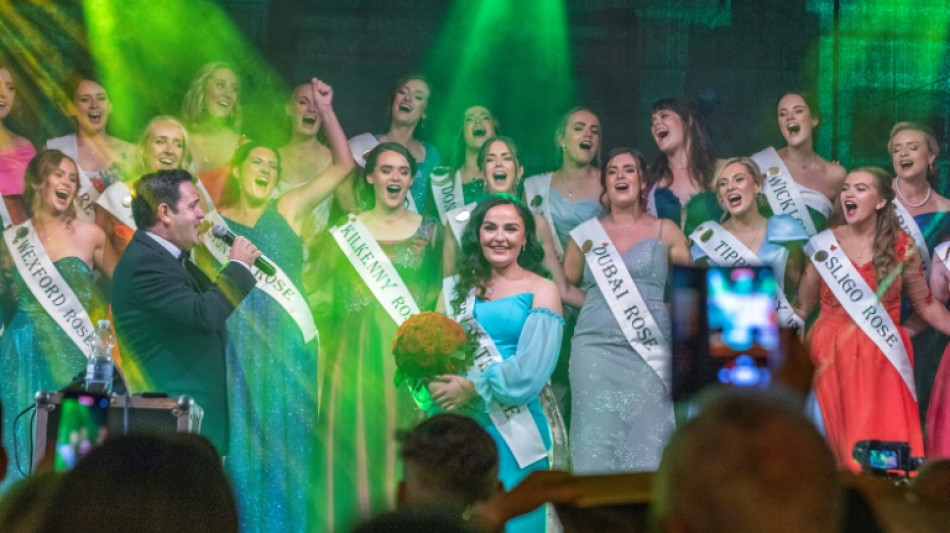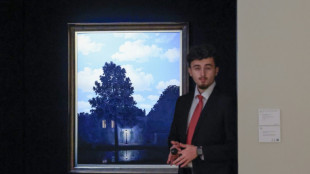
-
 Dutch police use hologram to try and decode sex worker's murder
Dutch police use hologram to try and decode sex worker's murder
-
Israel bombs south Beirut after Hezbollah targets Haifa area

-
 Biden in historic Amazon trip as Trump return sparks climate fears
Biden in historic Amazon trip as Trump return sparks climate fears
-
India hails 'historic' hypersonic missile test flight

-
 Israel orders Beirut residents to flee after Hezbollah targets Haifa area
Israel orders Beirut residents to flee after Hezbollah targets Haifa area
-
Davis, LeBron power Lakers over Pelicans as Celtics win in OT

-
 Trump and allies return to New York for UFC fights
Trump and allies return to New York for UFC fights
-
Hong Kong political freedoms in spotlight during bumper trial week

-
 Debt-saddled Laos struggles to tame rampant inflation
Debt-saddled Laos struggles to tame rampant inflation
-
Senna, Schumacher... Beganovic? Macau GP showcases future F1 stars

-
 India's vinyl revival finds its groove
India's vinyl revival finds its groove
-
G20 tests Brazil's clout in Lula 3.0 era

-
 Over 20,000 displaced by gang violence in Haiti: UN agency
Over 20,000 displaced by gang violence in Haiti: UN agency
-
Famed gymastics coach Bela Karolyi dies

-
 'Break taboos': Josep Borrell wraps up time as EU's top diplomat
'Break taboos': Josep Borrell wraps up time as EU's top diplomat
-
Climate finance can be hard sell, says aide to banks and PMs

-
 Trump revives 'peace through strength,' but meaning up to debate
Trump revives 'peace through strength,' but meaning up to debate
-
New York auction records expected for a Magritte... and a banana

-
 Egypt's middle class cuts costs as IMF-backed reforms take hold
Egypt's middle class cuts costs as IMF-backed reforms take hold
-
Beirut businesses struggle to stay afloat under Israeli raids

-
 Dupont lauds France 'pragmatism' in tight New Zealand win
Dupont lauds France 'pragmatism' in tight New Zealand win
-
Swiatek leads Poland into maiden BJK Cup semi-final

-
 Trump taps fracking magnate and climate skeptic as energy chief
Trump taps fracking magnate and climate skeptic as energy chief
-
West Indies restore pride with high-scoring win over England

-
 Hull clings to one-shot lead over Korda, Zhang at LPGA Annika
Hull clings to one-shot lead over Korda, Zhang at LPGA Annika
-
Xi tells Biden ready for 'smooth transition' to Trump

-
 Trump nominates fracking magnate and climate skeptic as energy secretary
Trump nominates fracking magnate and climate skeptic as energy secretary
-
Tyson says 'no regrets' over loss for fighting 'one last time'

-
 Springboks' Erasmus hails 'special' Kolbe after England try double
Springboks' Erasmus hails 'special' Kolbe after England try double
-
France edge out New Zealand in Test thriller

-
 Xi tells Biden will seek 'smooth transition' in US-China ties
Xi tells Biden will seek 'smooth transition' in US-China ties
-
Netherlands into Nations League quarter-finals as Germany hit seven

-
 Venezuela to free 225 detained in post-election unrest: source
Venezuela to free 225 detained in post-election unrest: source
-
Late Guirassy goal boosts Guinea in AFCON qualifying

-
 Biden arrives for final talks with Xi as Trump return looms
Biden arrives for final talks with Xi as Trump return looms
-
Dominant Sinner cruises into ATP Finals title decider with Fritz

-
 Dinosaur skeleton fetches 6 million euros in Paris sale
Dinosaur skeleton fetches 6 million euros in Paris sale
-
Netherlands-Hungary Nations League match interrupted by medical emergency

-
 Kolbe double as South Africa condemn England to fifth successive defeat
Kolbe double as South Africa condemn England to fifth successive defeat
-
Kolbe at the double as South Africa condemn England to fresh defeat

-
 Kolbe at the double as South Africa beat England 29-20
Kolbe at the double as South Africa beat England 29-20
-
'If I don't feel ready, I won't play singles,' says Nadal ahead of Davis Cup farewell

-
 Fifth of dengue cases due to climate change: researchers
Fifth of dengue cases due to climate change: researchers
-
Trump's Republican allies tread lightly on Paris pact at COP29

-
 Graham equals record as nine-try Scotland see off tenacious Portugal
Graham equals record as nine-try Scotland see off tenacious Portugal
-
Protesters hold pro-Palestinian march in Rio ahead of G20

-
 Graham equals record as nine-try Scotland see off dogged Portugal
Graham equals record as nine-try Scotland see off dogged Portugal
-
China's Xi urges APEC unity in face of 'protectionism'

-
 Japan's Kagiyama, Yoshida sweep gold in Finland GP
Japan's Kagiyama, Yoshida sweep gold in Finland GP
-
Macron to press Milei on climate action, multilateralism in Argentina talks


Traditional beauty pageant battles to keep pace in modern Ireland
As the Rose of Tralee beauty pageant concluded this week, the contestants in colourful ball gowns and silk sashes swayed as they sang the 19th-century ballad that inspired the competition.
"She was lovely and fair as the rose of the summer," they sang as this year's winner was paraded through the town in County Kerry, southwest Ireland, which gave the contest its name.
When all 33 contestants departed the stage, fireworks burst overhead and ticker tape ribbon fell from the sky.
The beauty pageant returned to Tralee and Ireland's living rooms after a two-year absence due to Covid restrictions to fanfare from its legions of fans.
But critics have raised questions about the pageant's relevance in modern Ireland and the diversity of its contestants, not least because of the show's all-white line up for 2022.
Created in 1959, the Rose of Tralee draws contestants, known as "roses", from across Ireland and around the world from the Irish diaspora.
All of them are winners of local selections that draw thousands of participants.
New York Rose Cathrena Collins, a 24-year-old law student, told AFP it had been "really special" to represent her city's Irish community, just as her grandmother had in 1965.
"It was huge for me. Growing up, I always heard stories. She always talked about what an honour it was," she explained.
- Modern Ireland -
The Rose of Tralee has been a major fixture on Irish television since it was first broadcast in 1967 and has had to adapt to the changing currents in Irish society to survive.
Mary McGill, an Irish lecturer and author, said it originates from a time when a "puritanical notion of Catholicism" was a "huge part" of Irish identity.
At the time, the church had an iron grip on Irish society and womanhood was put "under forms of extreme surveillance and extreme expectation around morality".
"I think because of its origins, that baggage is still there," she said, explaining, however, that Rose of Tralee is still "able to tap into the zeitgeist in a strange way".
"(It is) something that's uniquely Irish and quite traditionalist.
"It also has managed to have a new lease of life in the 21st century because of the connection it has to Irishness, nostalgia and the global community".
This year, the contestants wanted the pageant to reflect modern Ireland as much as possible.
Ireland, home to some five million people, has traditionally been a country of emigration but that began to change when its economy took off in the 1990s, notably with immigration from the EU.
Most people still class themselves as white Irish but ethnic diversity is increasing.
At the same time it has seen once unthinkable social change, including same-sex marriage and the liberalisation of strict abortion laws.
Wexford Rose Joy Quigley, a 26-year-old sometime bodybuilding competitor, showed off a sleeve tattoo on her right arm as she demonstrated muscle poses for the audience in a sparkling green evening gown.
"I think a modern Irish woman isn't your typical glamorous pretty princess," she said.
"We are a bit rough around the edges, and it's important to be relatable like that."
- Rule changes -
Broadcast over two consecutive evenings in prime time, the pageant frequently revels in its own brand of Irish kitsch.
During Tuesday's finale, one rose was admonished by a popular children's TV puppet after she revealed she had worked on a killing line in a poultry processing factory.
Grown men wept openly as a contestant from Queensland in northwest Australia read a poem about missing Ireland, including crisp sandwiches made with the nation's beloved Tayto brand.
Rose of Tralee also celebrates the bonds created by the competition in Irish communities.
Winning rose Rachel Duffy, from Westmeath in central Ireland, spoke of her pride in representing the rural community that had rallied around her following the death of her mother 14 years earlier.
Maysen Tinkler from Toronto, Canada, was diagnosed with autism a little over a year ago, and spoke of how other contestants had supported her.
In December, a series of rule changes were announced, allowing married women and trans-women to enter and raising the age limit from 28 to 29.
Despite the efforts, former Sydney Rose Brianna Parkins criticised the all-white line up during a radio debate for national broadcaster RTE.
"There just seems to be a lack of diversity across the board. It isn't just a racial issue here," the 2016 contestant said.
"We have some diverse people entering but I would love to see those numbers boosted because I don't think they're true reflections of Irish society at the minute."
Executive chair of the Rose of Tralee Anthony O'Gara dismissed the criticism as "lazy" and "nonsense", pointing out three of the last four winners had been of mixed ethnic origin.
"Frankly, I'm fed up with people... finding a different angle every year to have a go at the Rose of Tralee Festival," he added.
H.Gonzales--AT



